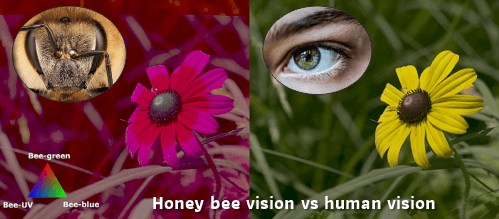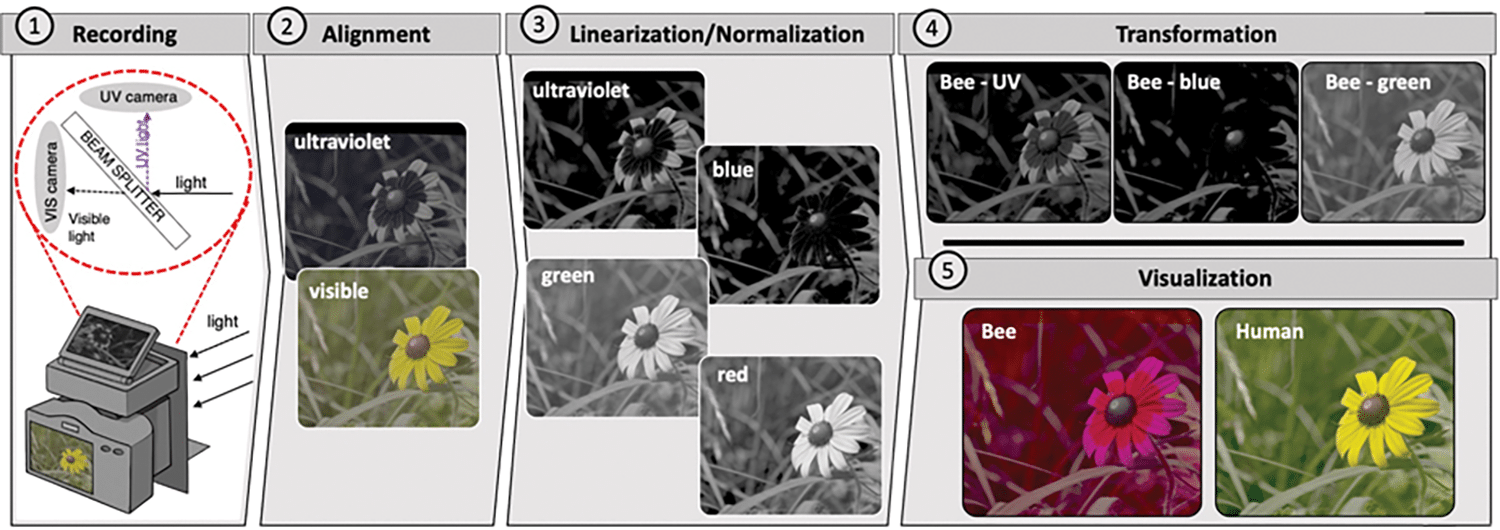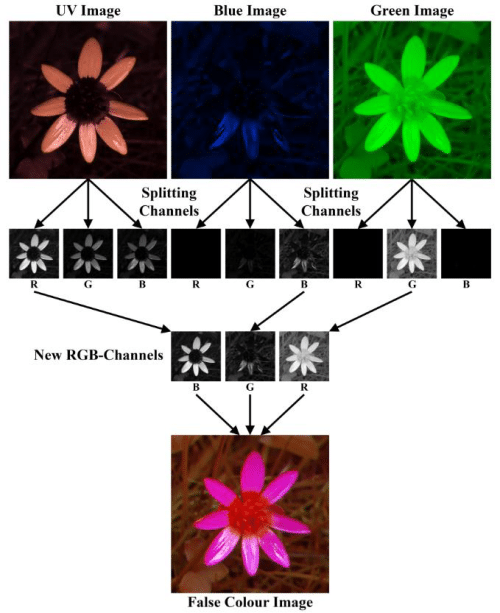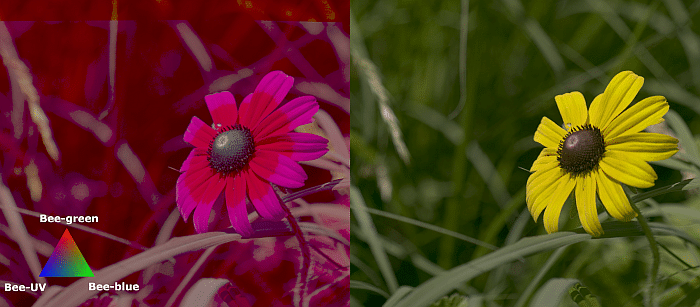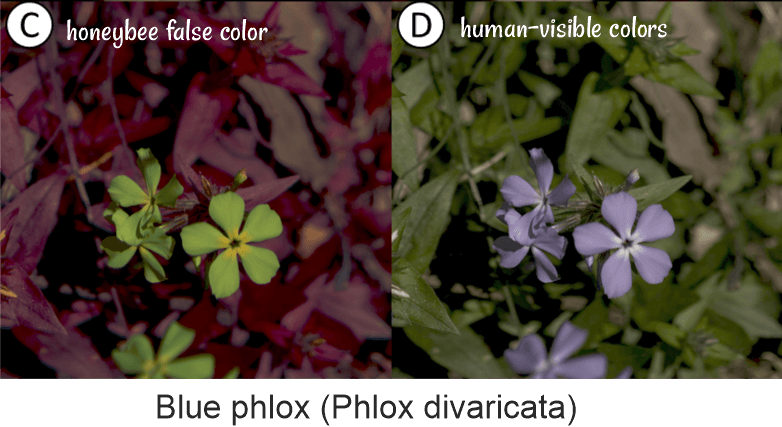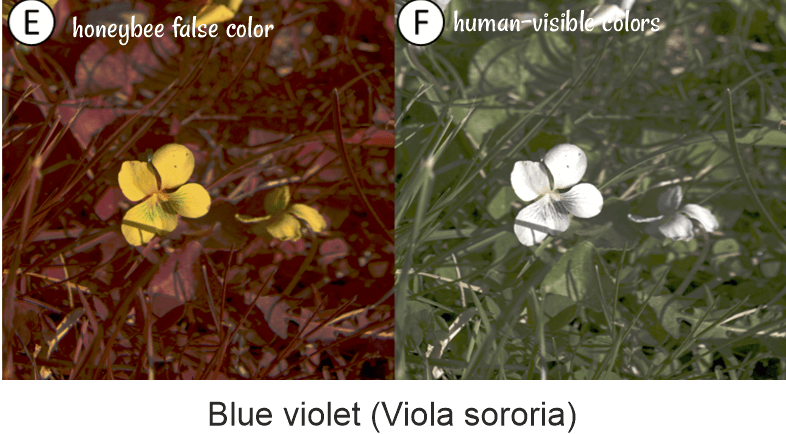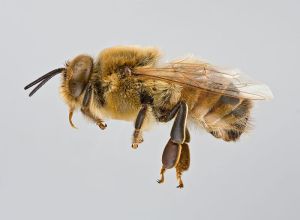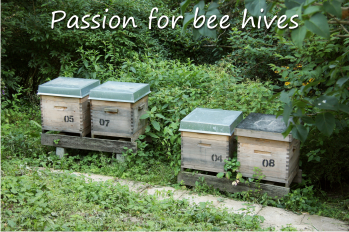Ever wondered how bees see flowers compared to how we see them? It’s like living in different worlds.
What we see is not what it is. The relativeness of things is once again thrown in our faces. A beautiful, amazing, colorful flower – one that inspires painters and poets – is really that beautiful? Or at least, is it real?
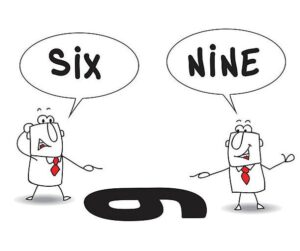
Honey bees definitely don’t see it as we do. They have 5 eyes. And through them, the world looks different.
Scientifically put it, honey bees vision range spectrum starts from 300nm wavelengh, which includes near ultraviolet waves and extends up to 650nm which is the color orange, as we know it. They cannot see red because they don’t have a photoreceptor for it.
Other insects (butterflies, moths, hoverflies, and beetles), reptiles, and certain bony fish can also see ultraviolet. Mosquitoes, vampire bats, bed bugs, and some snake and beetle species can even perceive infrared light.
Now, there are many colors that are made using red, which is a primary color. Red is a component of yellow, magenta, purple and white colours. If we exclude red from these colors, what do we see? How do honey bees see them?
Plants contain chemicals that either reflect or absorb electromagnetic radiation, including UV, visible, and infrared (which we cannot see but can feel as heat). Sunlight’s UV radiation is absorbed, partially absorbed, or reflected by flowers and can be captured on black and white photographic film or with a digital camera, using special filters.
How do honey bees see flowers?
Current methods of taking pictures as seen by the honey bees are good, but not perfect. They are called false color images. They are accurate; however, individually measuring reflectance spectra for each object in a visual display is laborious, and all spatial and temporal information is lost in the process. And they cannot record everything. There are powders and latticed materials, or objects that are iridescent, glossy, transparent, translucent, luminescent, or animals that shift their colors using iridophores, thus making them difficult or impossible to measure with spectrophotometry.
On January 23, 2024, a study published in PLOS Biology, conducted by Vera Vasas, from the University of Sussex, Brighton, United Kingdom, developed a novel camera system and software package with the ability to accurately record animal-perceived colors in motion. It captures the full complexity of visual signals, as perceived under natural contexts, where moving targets may be unevenly illuminated.
Vasas and her colleagues developed a portable 3-D-printed enclosure containing a beam splitter that separates light into UV and the human-visible spectrum. The two streams are captured by two different cameras. One is a standard camera that detects visible-wavelength light, and the other is a modified camera that is sensitive to UV.
The camera system records videos in 4 channels (UV, blue, green, and red) simultaneously, which are then processed to deliver footage as if it’s through the eyes of a particular insect/animal, based on what we know of their eye receptors.
In this example, the flower “black-eyed Susan” (Rudbeckia hirta) was recorded.
To the human eye this flower is entirely yellow, reflecting primarily long wavelength light.
(1) Scenes are projected to an internal beam splitter that reflects UV light and passes visible light to 2 independent cameras. This design eliminates the need for switching filters and so allows for the rapid collection of multispectral recordings (videos or images).
(2) align the recordings,
(3) linearize the recordings and automatically normalize them using the custom color card or a set of grayscales of known reflectivity. This step estimates the light captured by the camera sensors (camera catches).
(4) the camera catches are transformed into honey bee quantum catches,
(5) catches are visualized as false color images or videos (labeled as “bee”) by coloring the UV, blue, and green quantum catch images as blue, green, and red, respectively.
How does the world look like through a bee’s eyes?
Here is a video of bees foraging and interacting with flowers. It is shown in honeybee false colors (displaying the honeybee’s UV, blue, and green photoreceptor responses as blue, green, and red, respectively).
There are 3 short clips that depict bees foraging (first and second clips) and fighting (third clip) in their natural environment.
What is a bee false color image?
A false-color image is a recomposed image, considering the photoreceptors of the viewer.
The picture is digitally edited to split into color channels and then reassembled using other color channels. Thus, it is used a UV channel instead of blue, a blue channel instead of green, and a green channel instead of red in order to shift the wavelength range by about 100 nm.
read more: Can a honey bee see, smell, taste, touch, speak?
The study “False-color photography: a novel digital approach to visualize the bee view of flowers“, by Christian Verhoeven and Zong-Xin Ren showed how flowers looked in a bee’s eye, through the use of false color picture.
They took pictures with the UV, blue, and green filters and then split them into color channels in order to convert the merged picture into the RGB (red, green, blue) system, which is visible to humans. From the picture with UV filter the red channel, from that with blue filter the blue channel, and from that with green filter the green channel was used for merging.
In the bee false color image, the distal petals appear magenta because they also reflect UV, stimulating both the UV-sensitive photoreceptors (depicted as blue) and those sensitive to green light (depicted as red).
Here is an image of a black-eyed Susan (Rudbeckia hirta) depicted as a honey bee false color image and the same flower in human vision.
Unbelievable things about honey bees!
There is a visual key (bottom left corner) illustrating each of the bee’s 3 photoreceptors (vertices) and the colors used to represent the variable stimulation of these 3 photoreceptors (interior colors).
To humans, the black-eyed Susan appears entirely yellow because it reflects primarily long-wavelength light in the human-visible range. In the bee false color image, the distal petals appear magenta because they reflect UV in addition to long-wavelength light, stimulating both the photoreceptors sensitive to UV (depicted as blue) and those sensitive to green light (depicted as red).
By contrast, the central portion of the petals does not reflect UV and therefore appears red.
Here are some other pictures taken with the animal-view camera and a regular one.
References
https://cdnsciencepub.com/doi/10.1139/b02-116
• Vasas V, Lowell MC, Villa J, Jamison QD, Siegle AG, Katta PKR, et al. (2024) Recording animal-view videos of the natural world using a novel camera system and software package. PLoS Biol 22(1): e3002444. https://doi.org/10.1371/journal.pbio.3002444
• Verhoeven C, Ren Z-X, Lunau K. False-colour photography: a novel digital approach to visualize the bee view of flowers. J Pollinat Ecol. 2018;23:102–118.

